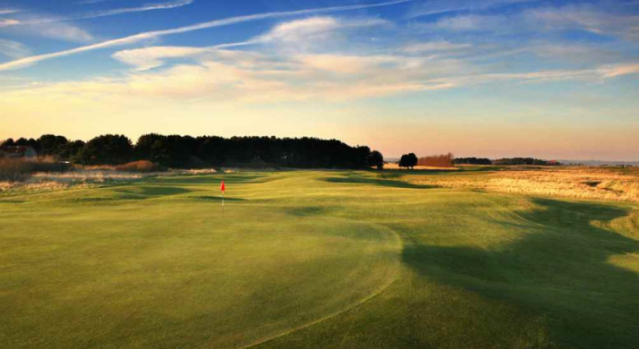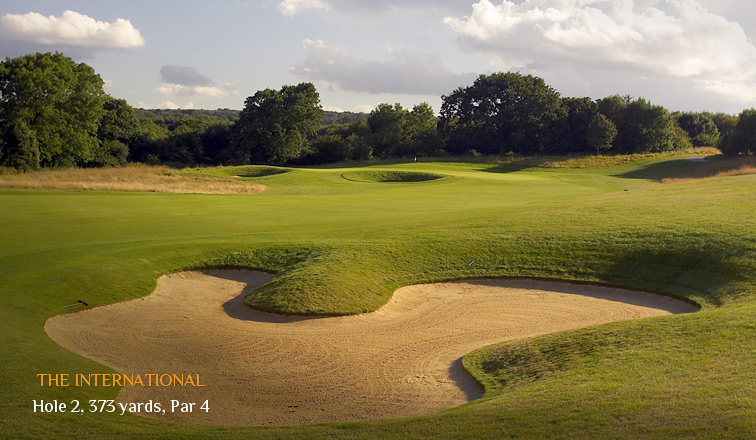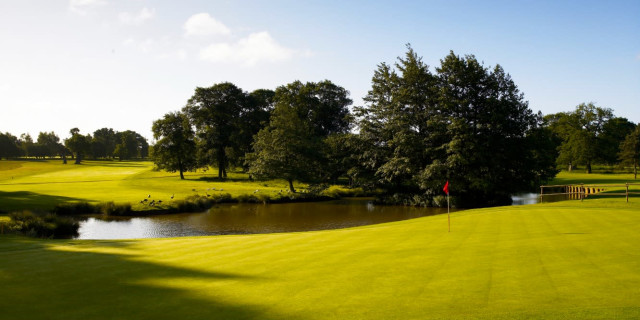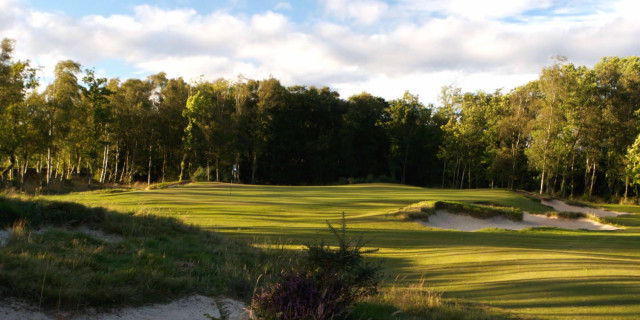10 of the Best - Golf Courses in Kent
Kent is known as the garden of England. It is one of the prettiest counties in the country, but with great links to places such as London. It also boasts many terrific golf courses - a great mix of links and parkland layouts, some of which have hosted top European Tour tournaments. Here, we recommend 10 of the best golf courses in Kent.
Royal St George's

- Par 70, 7,204 yards, links
- Green fee £180, winter/autumn £90-£110
The most famous course in Kent, Royal St George's is the course that finally gave Darren Clarke his first major victory in 2011 at The Open during a week in which players and spectators alike experienced four seasons in a day. It measures 7,204 yards and is a formidable par 70. The third hole is a par three measuring 239 yards. Originally played as a blind hole over a hill to the right of the present green, it was lengthened by 30 yards for the 2011 Open. Mounds surround the green and often send sliced shots back onto a two-tiered putting surface. Putts from the upper level to a pin at the bottom are lightning quick. It is one of the most difficult holes on the entire Open rota – and it doesn't have a single bunker.The 15th is 493 yards and a par four. A good drive between five bunkers will leave a carry over cross bunkers to a small green that falls away to the right. Miss the green on the left and you will be left with a tough pitch over bank. The 17th is a dogleg measuring 424 yards and features plenty of swales and humps. The green is the fastest on the course. It is slightly raised and is protected by bunkers on both sides. The final holes is 456 yards long and is one of the toughest finishing holes in golf. The tee shot must be well placed, and the approach could give you nightmares, with a deep bunker on the right of the green and two more on the left. The green slopes from right to left and features a swale known as Duncan's Hollow that swallows the ball and leaves a horrible chip – just ask Sandy Lyle
Hever Castle
- Par 72, 7,000 yards, parkland
- Green fee £37, winter £29
Hever Castle Golf Club, situated on the famous historic castle estate just 30 miles from London in West Kent, started as a nine-hole private layout for the Astor family in 1922.Well, every home should have one, don't you think. It was later neglected and fell into disrepair but in the 1990s new life was breathed into the place and it is now a magnificent par 72 measuring 7,000 yards. A further nine-hole course was built in 1998. Hever Castle is a parkland course but water features are the most notable hazards and come into play on three of the par threes. The 17th hole is a formidable 644-yard par five on which nobody is going to get home in two. It is a magnificent, traditional three-shot hole. The course has some wonderful bunkering and 18 superb greens.
Princes Golf Club

- Par 72, 6,880 yards, links
- Green fee £60, winter £50
Princes is a wondrous place, comprising three loops of nine holes. Most people play The Shore and The Dunes, and that is how we are going to review it, but The Himalayas is well worth a look too.
The first hole on The Shore course is a formidable 456-yard par four. The ideal line off the tee is just to the left of the right hand fairway bunkers but be careful not to venture too far left, as another bunker waits for the hooked tee shot. The second shot with a mid iron is struck towards a slightly elevated green that falls steeply left. The second is a 538-yard par five. You tee off next to the sea and aim for the right side of the fairway. Then you must choose whether or not to carry the cross bunkers and go for the green or lay up short and leave a pitch to the green, which has two parts. The raised left hand portion slopes from left to right and features a small tier, while the right side is flatter and easier to read. The fifth on The Dunes is a left to right dogleg, a par five measuring 518 yards with seven fairway bunkers. There are great views from the elevated tee across Prince's and nearby Royal St. Georges. The line from the tee is towards the middle bunker, but players must use caution to avoid the carnivorous pot bunkers guarding this opportunity to pick up a shot. The green is set on top of a dune, while a ditch on the left of the fairway awaits an errant second shot. The green is one of the longest on the course, measuring 38 yards, so club selection is key for your approach shots.
The Dunes forms an anticlockwise loop of nine holes – five out in a southerly direction to the boundary of Royal St. Georges and four back. The first hole is a dogleg and is the hardest on the course. It has a narrow green that is very difficult to hold with your approach shot. The fourth and fifth are both challenging par fours, offering no margin for error from the tee. There are great views from the sixth tee – it is a par five with trouble on both sides of the fairway and even nore lying in wait if you try to go for the green in two and go off line.
The Himalayas measures 3,201 yards and includes the sixth, a 580-yard par five that features a marshland water feature. Another unique aspect of these nine holes comes at the fourth and eighth, which share a huge double green, one of the few in play other than at the Old Course at St Andrews.
North Foreland Golf Club
- Par 71, 6,436 yards, links
- Green fee £45, winter £32, including coffee and bacon roll
North Foreland is located on the coast and on a pleasant spring or summer's day there are few better places to play golf. The second measures just 274 yards. All logic dictates that you should hit a mid iron and then a wedge, but the green can be reached with a good drive – if you go for it, keep the ball on target. The fifth is a par three measuring just 148 yards, and it seems that it should be a straightforward little hole – and it is if you use plenty of club and find the target. But the green is small and there's lot of trouble at the front. The eighth, at 465 yards, is a great par four. The fairway slopes from right to left, and bunkers await an approach that is even slightly wayward. At 412 yards, the 10th is another testing par four. This time the fairway slopes from left to right, so a draw is the perfect shot. The green has plenty of humps and hollows. The 12th is 433 yards and is regarded as the toughest hole on the course on account of the four fairway bunkers that have to be avoided with your drive and a second shot played to a narrow, two-tier putting surface. You finish with a 196-yard par three, with out of bounds on the left and behind the green to be avoided at all costs – play this course often enough and you will eventually run up a telephone number on this hole.
Chart Hills Golf Club

- Park 72, 7,132 yards, parkland
- Green fee £60, winter £50
This was the first course designed in Europe by Nick Faldo, the six-time major champion. Faldo played a great deal of his golf in America and those influences are clear to see at what many people still regard as his finest work. It lies in the heart of Kent and could be regarded as a parkland course on account of the many mature oak trees scattered around the course. But the American feel comes in the form of huge lakes and the numerous bunkers. It is a course that is very easy on the eye, but somewhat more difficult on the golf swing. Faldo made the most of the natural contours of the land and ensured that Chart Hills would be remembered for its wonderful undulating greens. There are 130 bunkers on the course, none more fearsome than the giant 'Anaconda' trap on the par five fifth hole. You will need to take a deep breath when you get to the 17th hole -it is a par three that measures 200 yards. As if that were not bad enough, it is played to an island green. Think of the 17th hole at Sawgrass with knobs on!
Littlestone Golf Course
- Par 71, 6,676 yards, links
- Green fee £75, winter £50
Littlestone is a delightful links course, complete with dunes, bracken and gorse. The third hole is a lovely par four, measuring just 398 yards. It features a blind tee shot over sand dunes. There is a marker post and the ideal line is slightly to the left of it, which will see your drive finish close to the bunkers at the angle of the dogleg and open up your approach to the green. There are no fairway bunkers on the 541-yard par five seventh but the green is well protected. A straight drive is a must and you then have to decide whether or not to try to clear the ditch with your second – if you can clear it you are left with a straightforward pitch to a narrow green, which is guarded by pot bunkers. The 12th features another blind drive, but this time to a wide fairway. It measures 430 yards and is usually played into the wind, which means a long approach shot. Ideally, you want to play your second from the left of the fairway. The green is the hardest on the course to read. The 17th is a memorable par three. It is 182 yards – if the wind is behind, you will be going in with something like an eight or nine iron, but if it is into your face you could be reaching for the driver. There are two bunkers short of the putting surface, and two more by the side of the green. The final hole is a 499-yard par five that is reachable in two for big hitters, but only if you find the fairway. If you can't make the surface in two you should keep your second shot to the left of the fairway to avoid a precipitous bunker on the right of the green.
The London Club Golf Club, International Course

- Par 72, 7,005 yards, parkland
- Green fee £105, winter £80
There are two Jack Nicklaus-designed courses at the London Club, and both are wonderful tests of golf. The International Course is open to visitors and hosted the 2014 Volvo World Matchplay, and The Heritage, which is restricted to members and their guests, hosted the 2008 European Open. Although the courses are inland, Nicklaus attempted to give them a links feel and came pretty close to pulling it off, especially if you play here during the summer. There is plenty of wispy rough, a huge number of magnificent trees, some of which are strategically placed near fairways, and the greens are magnificent. There are several glorious holes on the Heritage but the two that stand out are the par four 13th, played to a green that is guarded by water, and the 18th, which is played around a lake. The approach is to a raised green protected by deep bunkers. The International will stick in your memory for the quality of its par threes, especially the eighth and 12th, both of which require pinpoint accuracy as they are played over water.
Both are inland courses but with a links feel. There is plenty of water, challenging holes from a variety of tees and greens of the highest quality. Invariably in perfect condition, The Heritage’s signature holes are the par 4 13th with a green guarded by water and the unforgettable 18th which plays around a lake to a tricky raised green with cavernous bunkers. The International is renowned for its breathtaking par 3s at the 8th and 12th with full carries over water.
Wildernesse Golf Club
- Par 72, 6,539 yards, parkland
- Green fee £60, winter £40
Wildernesse proves that a golf course doesn't need to measure more than 7,000 yards to be a really good test. It is just 6,539 yards from the championshiptees and a par 72, but it is no pushover. It was first opened in 1890 and has a traditional parkland feel. There are hundreds of trees and that means you must hit the ball straight - or leave the driver in the bag. There are also plenty of bunkers to be avoided. The finishing holes offer a great challenge. The 16th measures 426 yards with trees lining both sides of the fairway, which slopes down towards the green. A well-protected putting surface makes for a difficult approach. The 17th, at 386 yards, is a dogleg left. The drive is uphill and requires an accurate shot to the right side of the fairway. If you go left you will be blocked out. The green slopes from left to right. The finishing hole is a 489-yard par five. When you stand on the tee, the trees on both sides make you feel that you are trying to thread your drive down a bowling alley, but it opens up. It is a dogleg right and a good, straight drive can run through the fairway and be blocked out by trees on the left. Once on the fairway the two fairway bunkers have to be avoided and the two-tier green is protected by a bunker to the right and trees to the left.
Royal Cinque Ports

- Par 71, 7,245 yards, links
- Green fee £130, winter £65
The best course in Kent, according to many locals – and that is a BIG claim. Snow is the only thing that closes this links, which has fast running fairways and a finishing stretch of holes that is one of the toughest you will ever face. So should you play the opening 11 holes well and feel that you are coasting, you could be in for a shock. The second nine consists of eight par fours and a solitary par three. The 12th is 463 yards, the 13th is 478 yards, the 15th 474 yards, the 16th 496 yards and the 18th is 455 yards. Oh yes, and that par three, the 14th, measures 221 yards and anything that finishes short will find its way to the left, while on the right are three bunkers. Ideally, you should start the ball to the right and draw it back. The 16th is the best, and toughest, hole on the links. Henry Cotton regarded it as one of the best 18 holes in England. You can either attempt to carry the cross bunker with your drive or play short, hit your second into the flat part of the fairway and leave a short approach. The elevated green is small and undulating. The final hole calls for a drive aimed towards the right side of the bridge that sits across a stream that is to be avoided at all costs. The second is played to another elevated green which is further away than it looks. There are no bunkers on this hole – it is tough enough without them. Phew!
Nizels Golf Club
- Par 72, 6,279 yards, parkland
- Green fee £40, winter £20
Nizels was built in 1992 on an estate that is more than 600 years old. It is located on high ground overlooking Kentish Weald countryside and offers some spectacular views. It is a parkland course, with many mature oak trees and a number of glorious water hazards -not so glorious if you fail to negotiate them, however. The second hole is a magnificent 553-yard par five played to a green protected by bunkers hidden by a range of hillocks. The drive on the par-four seventh will test your nerves - there is water on both sides and you have to hit your approach over more water to reach the green. Accuracy is the key on the 337-yard ninth hole too - you have to hit your drive through a relatively narrow avenue of trees - miss the short stuff and you are staring a double-bogey in the face. .
Related Content:
What do you think? post your thoughts and feedback on the Golfshake Forum: https://forum.golfshake.com/

















